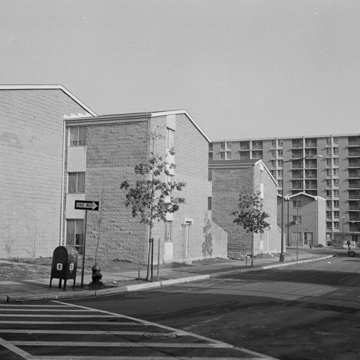Sursum Corda, meaning, “lift your spirits” in Latin, was a public housing project located several blocks away from Union Station in Northwest Washington, D.C. The development was designed by architectural collaboration Collins & Kronstadt–Leahy, Hogan, and Collins of Silver Spring, Maryland, and planned by a nonprofit group comprising Gonzaga High School graduates, Georgetown University students, community organizations, and religious institutions with financial support from the Department of Housing and Urban Development (HUD). Many of the incoming residents had been displaced by urban renewal and Sursum Corda therefore aimed to skirt the many mistakes previous public housing projects materialized. Hence, some residents paid market rate for their housing while others received federal subsidies or qualified for public housing units; out of 199 available units, 69 were dedicated to public housing. Housing advocates and government officials claimed that Sursum Corda “blazed the trail” for modern and inclusive public housing initiatives.
The site planning was done in collaboration with the residents. The cooperative conducted interviews with the first round of middle- to low-income families selected to move into the development in order to determine their needs. The outcome was residential clusters that encircled green spaces used as playgrounds; it is this opportunity for privacy that later rendered Sursum Corda a productive site for drug exchanges.
The architectural design consisted of a simple geometry and textured exterior tan blocks, aimed to resemble a Portuguese fishing village. While it is debatable whether this ambition was ever realized, the development aimed to accommodate a variety of needs and family sizes, thereby including variations of 3-6 bedroom town houses and a large number of 1-3 bedroom apartments with desirable amenities like washers and dryers, air conditioners, private gardens and entrances, and sliding glass doors—symbols of modern living. Community facilities were planned to include a small outdoor amphitheater and a community building with a clinic, meeting room, and library. Site planning likewise took seriously residential requirements for convenience. For example, many parts of the area were limited to vehicular access, thus ensuring that residents could safely enjoy the tree-lined streets.
In 1969, the development received an architectural design award from the Metropolitan Washington Board of Trade and was hailed as one of the most innovative housing projects in the country. It was visited by members of numerous domestic and international home builders and materials associations to learn about how industrial manufacturing processes could be applied to build sustainable low-income communities. Together with Charles M. Goodman’s Lake Anne development in nearby Reston, Sursum Corda offered a modernist and progressive version of humanistic design through collaborative work that would later inspire other public housing projects, like Paul Rudolph’s Shoreline Apartments in Buffalo.
Sursum Corda’s luck began to change barely two decades after completion. As early as 1988, maintenance of Sursum Corda stalled and the housing infrastructure deteriorated rapidly; residents complained about raw sewage leaking through the ceiling onto the lower floors and numbers of squatters energizing the illegal drug economy. The situation declined to a critical low in the early 1990s, prompting the community to relocate its public library in 1993 to a safer neighborhood. Municipal disregard for maintenance in combination with the crack epidemic of the late 1980s transformed Sursum Corda into one of the most popular open-air drug markets. Officers were also rarely sent to the development because of its confined arrangement and notorious history whereby the mere presence of federal prosecutors would culminate with a shootout. The violence reached a dreadful crescendo in 2004, when 14-year-old Jahkema Princess Hansen was executed after witnessing a murder.
After several unsuccessful attempts to sell the development to a private bidder in the 1990s and 2000s, the property was eventually sold to the Pennsylvania-based Toll Brothers Apartment Living company for $60 million. The firm filed raze permits in April 2018 with the proposition to construct a new luxury apartment complex with a small portion reserved for low-income residents. The elimination of a substantial low-income community provides insight into the affordable housing crisis in Washington, whereby scores of residents have been forced out of their neighborhoods by wealthier, younger, and often white, newcomers.
References
Kovaleski, Serge F., and David A. Fahrenthold. "NW Housing Complex a Tangle of Drugs, Despair." Washington Post, February 1, 2004.
National Capital Planning Commission. "Residential Construction in the District of Columbia: A Historical Survey," October 1963.
Roche, SIster DIane. "At Sursum Corda, Love Among the Ruins." Washington Post, February 18, 1990.
Ruvinsky, Aaron. "Tenants Ready: Renewal Project Lifts Hearts." Evening Star, July 25, 1969.
Welsh, James. "Northwest Renewal Gathering Steam." Washington Star, September 21, 1966.














